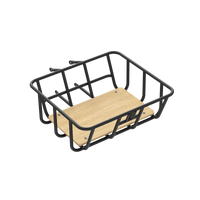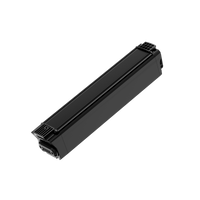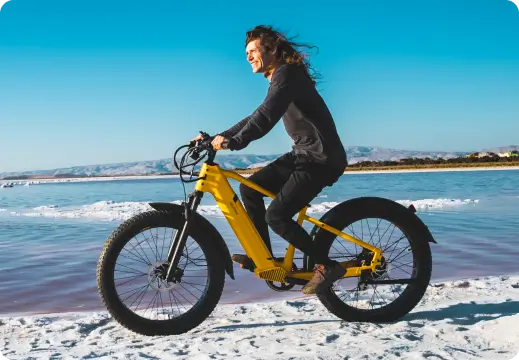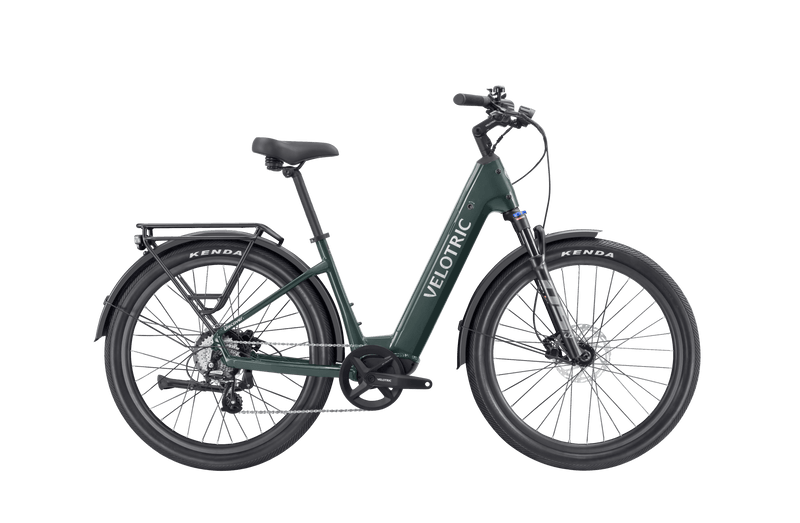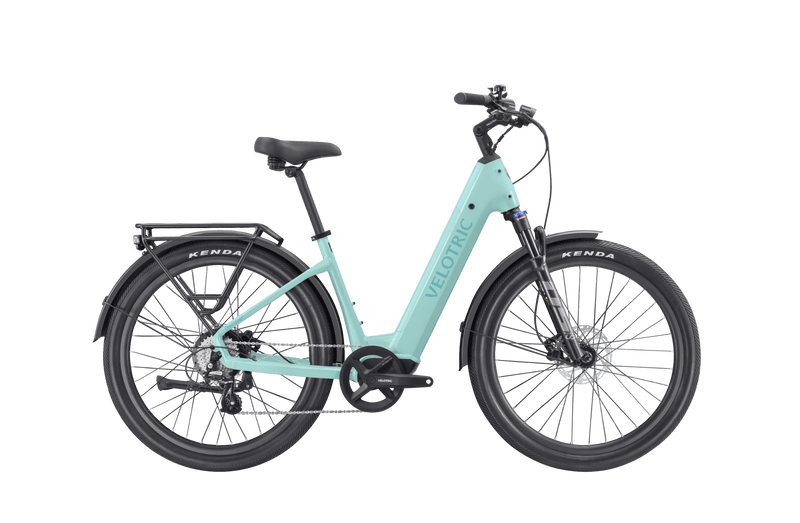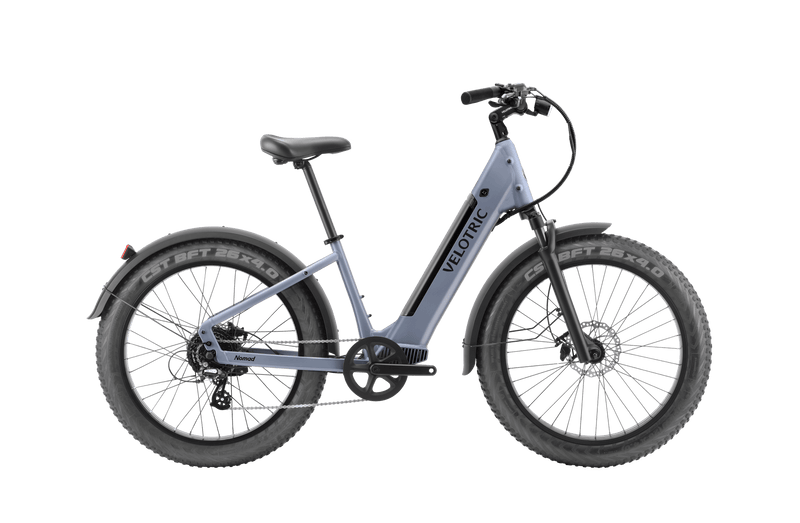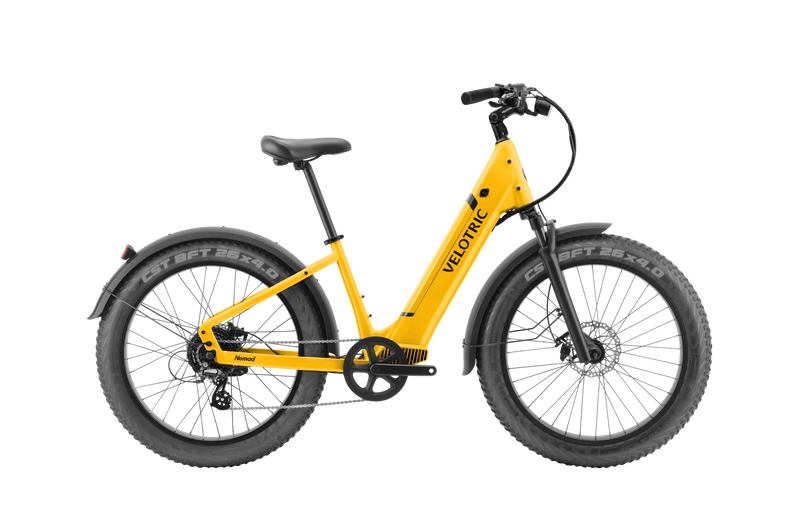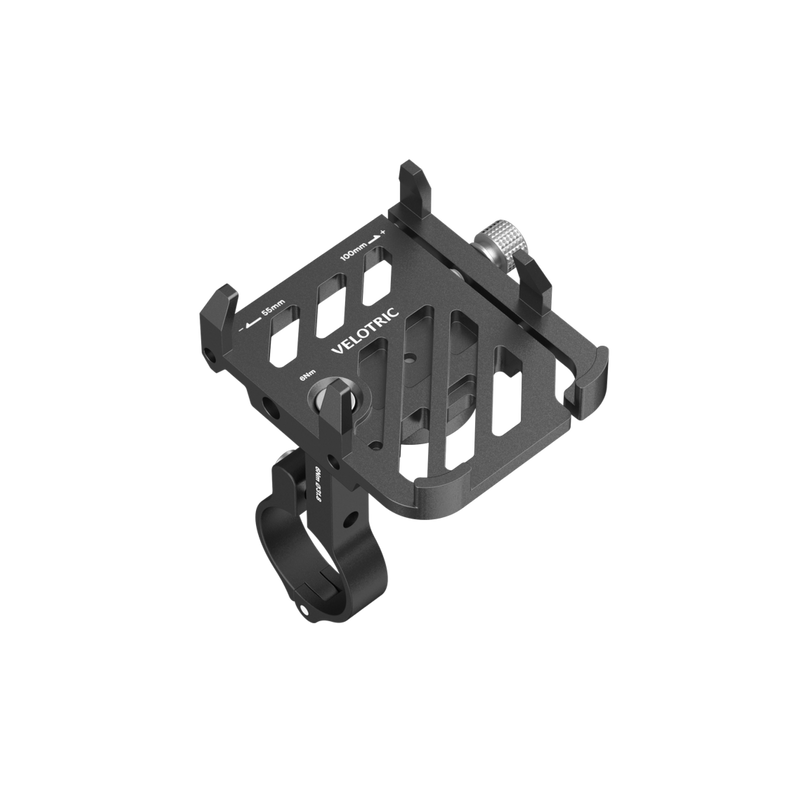There’s nothing fun about a bumpy e-bike ride that has you jostling. A rough ride can also be dangerous, increasing the risk you’ll fly off the seat, lose your grip on the handlebars, or slip your feet off the pedals.
The solution to a bumpy bike ride? Your e-bike suspension. The e-bike suspension allows the bike wheels to move up and down slightly, absorbing small bumps while maintaining contact with the ground.
A well-functioning suspension helps improve riding comfort and ensures you can maintain control on rough terrain. Read on to learn about the different types of suspensions and how they work.
Types of e-bike suspension
There are three main types of e-bike suspensions: front suspension, rear suspension, and full suspension. Discover the differences and learn which one might be right for you.
Front suspension forks
As the name suggests, the front suspension is at the front of the bike. The most common type of front suspension is the fork, which consists of two struts that connect the e-bike’s front wheel to the bike frame’s head tube (the nearly vertical part of the bike frame running from below the handlebars to the front wheel).
The fork includes an internal mechanical coil or air spring, which absorbs shock from the front wheel. Sliders or lowers connect the fork to the front wheel and the brakes, allowing the force of bumps and jumps to travel from the wheel to the fork’s mechanical coil or air spring when riding on rough terrain.
Front suspension is usually plenty for everyday riding — for example, if you’re commuting to work or riding for exercise. However, if you plan to ride off-road, you may want a bike with additional rear suspension (also known as a full-suspension bike).
Velotric’s Discover 1 and Nomad 1e-bikes come with a hydraulic suspension with 80 millimeters (mm) of travel (travel refers to how much a wheel can move up and down on rough terrain).
For context, 80 mm is great for everyday riding, while mountain bikes or dirt bikes may travel up to 200 mm.
Rear suspension
Again, it’s all in the name: Rear suspension, or rear shock, is at the back of the bike. A rear suspension system usually consists of a coil spring (not an air spring). An extra shock absorber at the back helps absorb impact and improve tire contact with the ground, which boosts control and reduces fatigue.
Having front suspension is usually enough for everyday cyclists who aren’t off-roading. However, those who want to ride on unpaved surfaces may also want rear suspension (a bike with front and rear suspension is a full-suspension bike — more on that next).
Full suspension
Some bikes include rear suspension and front suspension, known as full suspension or dual-suspension. For example, mountain e-bike (MTB) cyclists can benefit from a full-suspension system since off-roading tends to involve bumpy, unpaved terrain.
A full-suspension bike generally offers a more comfortable ride than a hardtail bike (the term for a bike with only one suspension). That said, full-suspension bikes are usually more expensive to buy and maintain. They’re also heavier.
A full-suspension system is usually only necessary for extreme riding, like mountain biking. You can tackle rougher trails with drops, rocks, and roots with full suspension. Cyclists with joint troubles may also benefit from full suspension, even if they aren’t doing extreme riding.
How suspension works
A bike’s suspension system includes a mechanical coil or an air spring (front suspensions can be either, while rear suspensions are usually coil-based). This mechanism absorbs the kinetic energy from the bike wheels when they make impact with the ground, for example, after riding over a bump or making a jump.
In addition to the spring, the suspension includes a damper. The damper helps dissipate the kinetic energy the spring absorbs so the suspension doesn’t bounce out of control. Most dampers are filled with oil.
When a force travels from the bike wheel to the suspension, the air spring or coil contracts, absorbing the shock. The damper then spreads that shock, allowing the coil or spring to release, rebound, and extend fully, ready to absorb the next bounce.
Factors to consider when choosing an e-bike with suspension
Now that you’ve got an idea of how an e-bike suspension works, you’re probably wondering which one is right for you. There’s no one-size-fits-all when it comes to bike suspensions.
Here are some factors to consider when selecting suspension.
Terrain
If you’ll be riding in the city on paved surfaces, a full-suspension e-bike isn’t necessary. However, if you have an electric mountain bike (EMTB) and plan to ride on unpaved surfaces — like over rocks, roots, and jumps — you want a dual-suspension bike for maximum shock absorption.
Riding style
Riding style is another consideration. Even urban cyclists may want to fly over curbs and other obstacles, which can make rear suspension invaluable. If you’re a high-speed cyclist, opt for a full-suspension road bike or e-bike.
Cost
Cost is also a consideration when buying an e-bike, and suspension type impacts cost. A high-endelectric mountain bike with full suspension will cost more than an everyday commuter bike with a single suspension system.
If cost is a concern, a single-suspension model is for you.
Maintenance and care of e-bike suspension
Your e-bike suspension is an essential e-bike component (learn about some other important parts). By properly caring for your e-bike’s suspension, you can help ensure it works optimally and extend its longevity.
Here are some basic bike maintenance steps to help protect your suspension.
Checking and adjusting air pressure
If your bike’s tires aren’t sufficiently inflated, they won’t have enough air to help absorb shock. The suspension has to work harder as a result.
Use a standard bike pump to check your tire pressure before every ride, ensuring it’s in the recommended range printed on the side of the tire. If the pressure is too low, add air.
Lubrication
It’s not advisable to lubricate the suspension, as this can cause grit to get stuck in the suspension. However, you should lubricate other parts of your bike, like the chain, to reduce friction and minimize stress on the bike, including the shocks.
Learn more about lubricating bike chains and other key maintenance steps.
Regular inspection and service
Regular inspections at a local bike shop can help ensure the suspension and other key components are in good working order. Casual cyclists can get by with an annual inspection, while those riding 100 miles or more per week should get an inspection every three to four months.
Your bike’s manual may also recommend how frequently it needs inspections.
Discover the best Velotric electric bike for you
A well-functioning bike suspension is just one element that makes for a smoother ride. To maximize your comfort, opt for an e-bike with a well-designed frame and top-quality components. Velotric is the answer.
Our bikes have a 220-mm-wide ergonomic seat so that you can enjoy long rides comfortably. Plus, our bikes offer two models of frames, suitable for different heights: The step-through model is for riders 5’1” to 6’4”, while the high-step model is for those 5’6” to 6’9” (learn about different frame types).
For peace of mind, Velotric electric bicycles have safety features like Shimanohydraulic disc brakes and lights at the front and rear wheels. The electric bike suspension includes 80 mm of travel and a lock-out activation switch, which you can use to adjust the suspension as needed.
Velotric has two main bike models: Our Discover 1 is great for everyday riding, while our Nomad 1fat tire e-bike lets you tackle unpaved surfaces. Both e-bikes have five-level pedal assist, throttle assist, and high-qualitylithium-ion batteries that charge completely in six hours.
Find your local Velotric dealer to book a test ride.























